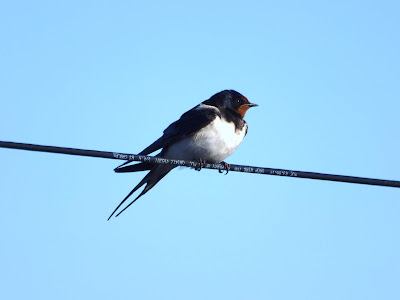Whilst spring brings an enormous variety of migrants, perhaps the most iconic is the Swallow. Swallows and Martins arrive at our doors having travelled thousands of miles from their wintering grounds. Here to breed, they will soon be filling the skies with their acrobatic and elegant swoops and dives. In the UK we have 3 regular species of Swallows and Martins, all of which can be found here within Dumfries and Galloway. Sitting next to each other they might be easy enough to identify, however in the high-speed pursuit of insects they can be a lot tougher to pick out. In this article, I hope to provide a beginner's guide to identifying Martins, with some tips and tricks to picking our common species apart, as well as some other similar species.
Swallows (technically Barn Swallows but I've never heard anyone use that) are the most well-known of the family, and probably the easiest to identify. Slightly larger than Chaffinches, they have a distinctive dark blue back, white undersides and if you're close enough to see it, a deep red face. These can be very hard to pick out when on the wing however, especially when flying low and fast, mixed amongst other Swallows and Martins. Here, its most key feature is its long streaming tail feathers, which fork out and extend for a very noticeable 3 - 6 cm. Adult males will have the longest tail-streamers, however juveniles and females still possess them, and it is the key feature to notice when separating them from the various Martins.
House Martins are in fact slightly smaller than Swallows, but this is easily missed unless compared side by side. Otherwise, they are very similar with dark backs and white underbellies. Once again their identifying feature lies at their rear. Their tail feathers are slightly forked, however not nearly as long as the Swallows. Additionally, they have a large white patch on their rumps, which is very easy to pick out, even at long distances.
Smallest of the bunch (though again, by a very marginal difference) are the Sand Martins. Unlike the previous two species, they tend to avoid urban areas for nesting sites, preferring the sandy banks (hence the name) of gravel-pits or rivers. These habitats can still be close enough to nesting sites of other Martins that they can share the same feeding grounds, indeed we see all of these species when around the Wig. Breaking the trend, Sand Martins are noticeably brown when compared to House Martins, and their pale underbellies are broken by a brown stripe. They lack any kind of rump patch and have very short, square tail feathers to easily distinguish them from Swallows.
Last of these aerial acrobats are the Swifts, who are in fact from an entirely different family than Swallows and Martins (something to do with their feet being unsuitable for perching). Very close to a Swallow in size, they share the same habitats and so can often be found feeding alongside them, leading to much confusion when identifying them. Fortunately, Swifts are dark all over, and have a very large, crescent moon shaped wingspan. If these weren't enough to pick them out, they can be identified by their ringing, scream-like calls.
Normally at this point, I mention some occasional rarities that you could also look out for, however, in Europe we don't have that many Swallows and Martins (1 more Swallow, and 3 more Martin species) all of which stick to Southern Europe, or even across the Mediterranean in Africa. Over the past couple of years though, we have had individual records of an Alpine Swift and a Pallid Swift. These are very rare visitors, again preferring the warmer south. If you are fortunate enough to find one, Alpine Swifts can be identified from their regular cousins by white patches on their throat and belly. They are also much larger, and so will stand out amongst other Swifts and Swallows. Pallid Swifts are much more similar to our regular birds, and so its probably better to leave those to the experts (of which I am not). Not that we are likely to see them, but if you take a Mediterranean holiday it might be worth looking over them once again.
Whilst there might only be 4 species in this guide, they are all very similar, and importantly can all be seen within Dumfries and Galloway. Hopefully, these tips will give you some confidence in identifying these aerial masters, and with spring underway, the skies will soon be full of targets for you to practise on!
[All photographs were taken by and belong to Stephen Grover, please ask for permission if you wish to use them.]











